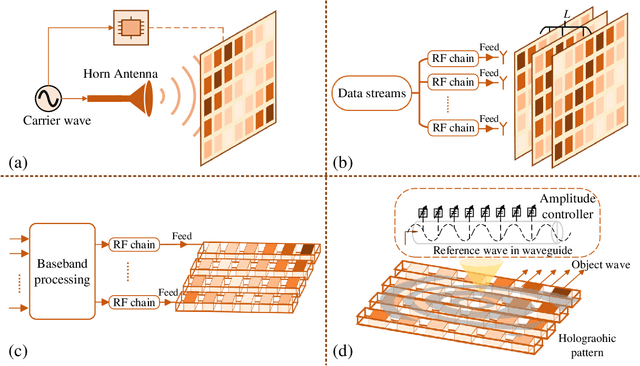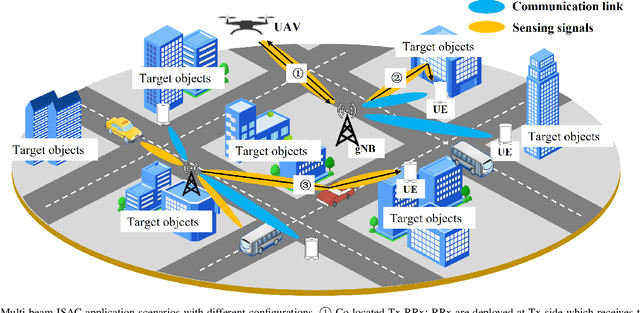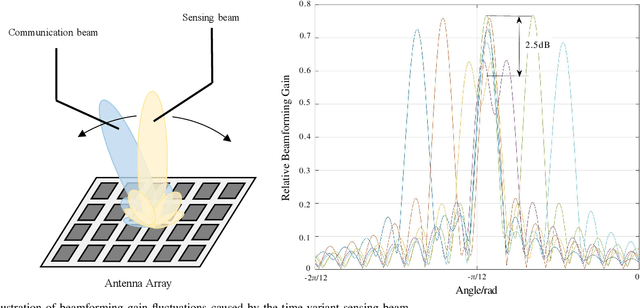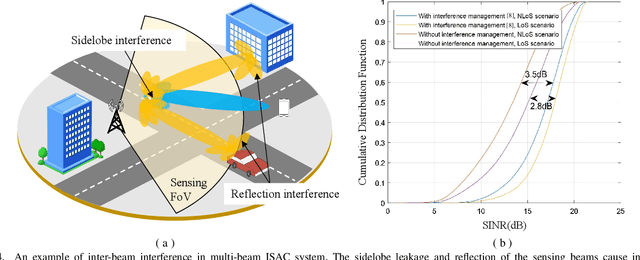Tianqi Mao
NEFT: A Unified Transformer Framework for Efficient Near-Field CSI Feedback in XL-MIMO Systems
Sep 16, 2025Abstract:Extremely large-scale multiple-input multiple-output (XL-MIMO) systems, operating in the near-field region due to their massive antenna arrays, are a key enabler of next-generation wireless communications but face significant challenges in channel state information (CSI) feedback. Deep learning has emerged as a powerful tool by learning compact CSI representations for feedback. However, existing methods struggle to capture the intricate structure of near-field CSI while incurring prohibitive computational overhead on practical mobile devices. To overcome these limitations, we propose the Near-Field Efficient Feedback Transformer (NEFT) family for accurate and efficient near-field CSI feedback across diverse hardware platforms. Built on a hierarchical Vision Transformer backbone, NEFT is extended with lightweight variants to meet various deployment constraints: NEFT-Compact applies multi-level knowledge distillation (KD) to reduce complexity while maintaining accuracy, and NEFT-Hybrid and NEFT-Edge address encoder- and edge-constrained scenarios via attention-free encoding and KD. Extensive simulations show that NEFT achieves a 15--21 dB improvement in normalized mean-squared error (NMSE) over state-of-the-art methods, while NEFT-Compact and NEFT-Edge reduce total FLOPs by 25--36% with negligible accuracy loss. Moreover, NEFT-Hybrid lowers encoder-side complexity by up to 64%, enabling deployment in highly asymmetric device scenarios. These results establish NEFT as a practical and scalable solution for near-field CSI feedback in XL-MIMO systems.
Jamming Identification with Differential Transformer for Low-Altitude Wireless Networks
Aug 17, 2025Abstract:Wireless jamming identification, which detects and classifies electromagnetic jamming from non-cooperative devices, is crucial for emerging low-altitude wireless networks consisting of many drone terminals that are highly susceptible to electromagnetic jamming. However, jamming identification schemes adopting deep learning (DL) are vulnerable to attacks involving carefully crafted adversarial samples, resulting in inevitable robustness degradation. To address this issue, we propose a differential transformer framework for wireless jamming identification. Firstly, we introduce a differential transformer network in order to distinguish jamming signals, which overcomes the attention noise when compared with its traditional counterpart by performing self-attention operations in a differential manner. Secondly, we propose a randomized masking training strategy to improve network robustness, which leverages the patch partitioning mechanism inherent to transformer architectures in order to create parallel feature extraction branches. Each branch operates on a distinct, randomly masked subset of patches, which fundamentally constrains the propagation of adversarial perturbations across the network. Additionally, the ensemble effect generated by fusing predictions from these diverse branches demonstrates superior resilience against adversarial attacks. Finally, we introduce a novel consistent training framework that significantly enhances adversarial robustness through dualbranch regularization. Simulation results demonstrate that our proposed methodology is superior to existing methods in boosting robustness to adversarial samples.
Secure Transmission for Cell-Free Symbiotic Radio Communications with Movable Antenna: Continuous and Discrete Positioning Designs
Aug 09, 2025Abstract:In this paper, we study a movable antenna (MA) empowered secure transmission scheme for reconfigurable intelligent surface (RIS) aided cell-free symbiotic radio (SR) system. Specifically, the MAs deployed at distributed access points (APs) work collaboratively with the RIS to establish high-quality propagation links for both primary and secondary transmissions, as well as suppressing the risk of eavesdropping on confidential primary information. We consider both continuous and discrete MA position cases and maximize the secrecy rate of primary transmission under the secondary transmission constraints, respectively. For the continuous position case, we propose a two-layer iterative optimization method based on differential evolution with one-in-one representation (DEO), to find a high-quality solution with relatively moderate computational complexity. For the discrete position case, we first extend the DEO based iterative framework by introducing the mapping and determination operations to handle the characteristic of discrete MA positions. To further reduce the computational complexity, we then design an alternating optimization (AO) iterative framework to solve all variables within a single layer. In particular, we develop an efficient strategy to derive the sub-optimal solution for the discrete MA positions, superseding the DEO-based method. Numerical results validate the effectiveness of the proposed MA empowered secure transmission scheme along with its optimization algorithms.
Multiple-Mode Affine Frequency Division Multiplexing with Index Modulation
Jul 17, 2025Abstract:Affine frequency division multiplexing (AFDM), a promising multicarrier technique utilizing chirp signals, has been envisioned as an effective solution for high-mobility communication scenarios. In this paper, we develop a multiple-mode index modulation scheme tailored for AFDM, termed as MM-AFDM-IM, which aims to further improve the spectral and energy efficiencies of AFDM. Specifically, multiple constellation alphabets are selected for different chirp-based subcarriers (chirps). Aside from classical amplitude/phase modulation, additional information bits can be conveyed by the dynamic patterns of both constellation mode selection and chirp activation, without extra energy consumption. Furthermore, we discuss the mode selection strategy and derive an asymptotically tight upper bound on the bit error rate (BER) of the proposed scheme under maximum-likelihood detection. Simulation results are provided to demonstrate the superior performance of MM-AFDM-IM compared to conventional benchmark schemes.
Intelligent Metasurface-Enabled Integrated Sensing and Communication: Unified Framework and Key Technologies
Jun 16, 2025



Abstract:As the demand for ubiquitous connectivity and high-precision environmental awareness grows, integrated sensing and communication (ISAC) has emerged as a key technology for sixth-generation (6G) wireless networks. Intelligent metasurfaces (IMs) have also been widely adopted in ISAC scenarios due to their efficient, programmable control over electromagnetic waves. This provides a versatile solution that meets the dual-function requirements of next-generation networks. Although reconfigurable intelligent surfaces (RISs) have been extensively studied for manipulating the propagation channel between base and mobile stations, the full potential of IMs in ISAC transceiver design remains under-explored. Against this backdrop, this article explores emerging IM-enabled transceiver designs for ISAC systems. It begins with an overview of representative IM architectures, their unique principles, and their inherent advantages in EM wave manipulation. Next, a unified ISAC framework is established to systematically model the design and derivation of diverse IM-enabled transceiver structures. This lays the foundation for performance optimization, trade-offs, and analysis. The paper then discusses several critical technologies for IM-enabled ISAC transceivers, including dedicated channel modeling, effective channel estimation, tailored beamforming strategies, and dual-functional waveform design.
Toward Near-Space Communication Network in the 6G and Beyond Era
May 18, 2025Abstract:Near-space communication network (NS-ComNet), as an indispensable component of sixth-generation (6G) and beyond mobile communication systems and the space-air-ground-sea integrated network (SAGSIN), demonstrates unique advantages in wide-area coverage, long-endurance high-altitude operation, and highly flexible deployment. This paper presents a comprehensive review of NS-ComNet for 6G and beyond era. Specifically, by contrasting satellite, low-altitude unmanned-aerial-vehicle (UAV), and terrestrial communications, we first elucidate the background and motivation for integrating NS-ComNet into 6G network architectures. Subsequently, we review the developmental status of near-space platforms, including high-altitude balloons, solar-powered UAVs, and stratospheric airships, and analyze critical challenges faced by NS-ComNet. To address these challenges, the research focuses on key enabling technologies such as topology design, resource and handover management, multi-objective joint optimization, etc., with particular emphasis on artificial intelligence techniques for NS-ComNet. Finally, envisioning future intelligent collaborative networks that integrate NS-ComNet with satellite-UAV-terrestrial systems, we explore promising directions. This paper aims to provide technical insights and research foundations for the systematic construction of NS-ComNet and its deep deployment in the 6G and beyond era.
AFDM-Enabled Integrated Sensing and Communication: Theoretical Framework and Pilot Design
Feb 20, 2025Abstract:The integrated sensing and communication (ISAC) has been envisioned as one representative usage scenario of sixth-generation (6G) network. However, the unprecedented characteristics of 6G, especially the doubly dispersive channel, make classical ISAC waveforms rather challenging to guarantee a desirable performance level. The recently proposed affine frequency division multiplexing (AFDM) can attain full diversity even under doubly dispersive effects, thus becoming a competitive candidate for next-generation ISAC waveforms. Relevant investigations are still at an early stage, which involve only straightforward design lacking explicit theoretical analysis. This paper provides an in-depth investigation on AFDM waveform design for ISAC applications. Specifically, the closed-form Cr\'{a}mer-Rao bounds of target detection for AFDM are derived, followed by a demonstration on its merits over existing counterparts. Furthermore, we formulate the ambiguity function of the pilot-assisted AFDM waveform for the first time, revealing conditions for stable sensing performance. To further enhance both the communication and sensing performance of the AFDM waveform, we propose a novel pilot design by exploiting the characteristics of AFDM signals. The proposed design is analytically validated to be capable of optimizing the ambiguity function property and channel estimation accuracy simultaneously as well as overcoming the sensing and channel estimation range limitation originated from the pilot spacing. Numerical results have verified the superiority of the proposed pilot design in terms of dual-functional performance.
Reinforcement-Learning-Enabled Beam Alignment for Water-Air Direct Optical Wireless Communications
Sep 05, 2024Abstract:The escalating interests on underwater exploration/reconnaissance applications have motivated high-rate data transmission from underwater to airborne relaying platforms, especially under high-sea scenarios. Thanks to its broad bandwidth and superior confidentiality, Optical wireless communication has become one promising candidate for water-air transmission. However, the optical signals inevitably suffer from deviations when crossing the highly-dynamic water-air interfaces in the absence of relaying ships/buoys. To address the issue, this article proposes one novel beam alignment strategy based on deep reinforcement learning (DRL) for water-air direct optical wireless communications. Specifically, the dynamic water-air interface is mathematically modeled using sea-wave spectrum analysis, followed by characterization of the propagation channel with ray-tracing techniques. Then the deep deterministic policy gradient (DDPG) scheme is introduced for DRL-based transceiving beam alignment. A logarithm-exponential (LE) nonlinear reward function with respect to the received signal strength is designed for high-resolution rewarding between different actions. Simulation results validate the superiority of the proposed DRL-based beam alignment scheme.
Transmit Beamforming Design for ISAC with Stacked Intelligent Metasurfaces
Sep 05, 2024Abstract:This paper proposes a transmit beamforming strategy for the integrated sensing and communication (ISAC) systems enabled by the novel stacked intelligent metasurface (SIM) architecture, where the base station (BS) simultaneously performs downlink communication and radar target detection via different beams. To ensure superior dual-function performance simultaneously, we design the multi-layer cascading beamformer by maximizing the sum rate of the users while optimally shaping the normalized beam pattern for detection. A dual-normalized differential gradient descent (D3) algorithm is further proposed to solve the resulting non-convex multi-objective problem (MOP), where gradient differences and dual normalization are employed to ensure a fair trade-off between communication and sensing objectives. Numerical results demonstrate the superiority of the proposed beamforming design in terms of balancing communication and sensing performance.
Multi-Beam Integrated Sensing and Communication: State-of-the-Art, Challenges and Opportunities
May 31, 2024



Abstract:Integrated sensing and communication (ISAC) has been envisioned as a critical enabling technology for the next-generation wireless communication, which can realize location/motion detection of surroundings with communication devices. This additional sensing capability leads to a substantial network quality gain and expansion of the service scenarios. As the system evolves to millimeter wave (mmWave) and above, ISAC can realize simultaneous communications and sensing of the ultra-high throughput level and radar resolution with compact design, which relies on directional beamforming against the path loss. With the multi-beam technology, the dual functions of ISAC can be seamlessly incorporated at the beamspace level by unleashing the potential of joint beamforming. To this end, this article investigates the key technologies for multi-beam ISAC system. We begin with an overview of the current state-of-the-art solutions in multi-beam ISAC. Subsequently, a detailed analysis of the advantages associated with the multi-beam ISAC is provided. Additionally, the key technologies for transmitter, channel and receiver of the multi-beam ISAC are introduced. Finally, we explore the challenges and opportunities presented by multi-beam ISAC, offering valuable insights into this emerging field.
 Add to Chrome
Add to Chrome Add to Firefox
Add to Firefox Add to Edge
Add to Edge